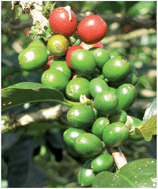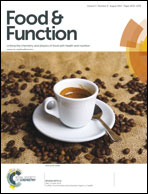Coffee: biochemistry and potential impact on health
Abstract
This review provides details on the phytochemicals in green coffee beans and the changes that occur during roasting. Key compounds in the coffee beverage, produced from the ground, roasted beans, are volatile constituents responsible for the unique aroma, the alkaloids caffeine and trigonelline, chlorogenic acids, the diterpenes cafestol and kahweol, and melanoidins, which are Maillard reaction products. The fate of these compounds in the body following consumption of coffee is discussed along with evidence of the mechanisms by which they may impact on health. Finally, epidemiological findings linking coffee consumption to potential health benefits including prevention of several chronic and degenerative diseases, such as cancer, cardiovascular disorders, diabetes, and Parkinson's disease, are evaluated.

- This article is part of the themed collection: VI International Conference on Polyphenols and Health

 Please wait while we load your content...
Please wait while we load your content...